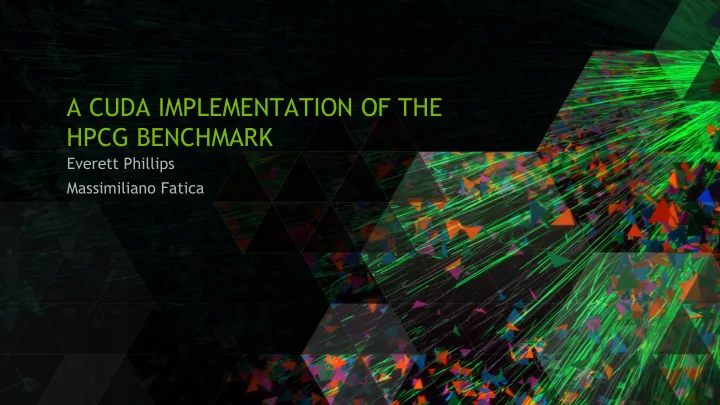

A CUDA IMPLEMENTATION OF THE HPCG BENCHMARK Everett Phillips Massimiliano Fatica
OUTLINE High Performance Conjugate Gradient Benchmark Motivation Overview Optimization Performance Results Single GPU GPU Supercomputers Conclusion
WHY HPCG ? HPL (Linpack) Top500 benchmark Supercomputer Ranking / Evaluation Dense Linear Algebra (Ax = b) Compute intensive DGEMM (Matrix-Matrix Multiply) O(N3)FLOPS / O(N2) Data 10-100 Flop/Byte Workload does not correlate with many modern applications
WHY HPCG? New Benchmark to Supplement HPL Common Computation Patterns not addressed by HPL Numerical Solution of PDEs Memory Intensive Network
HPCG BENCHMARK Preconditioned Conjugate Gradient Algorithm Sparse Linear Algebra (Ax = b), Iterative solver Bandwidth Intensive: 1/6 Flop/Byte Simple Problem (sparsity pattern of Matrix A) Simplifies matrix generation/solution validation Regular 3D grid, 27-point stencil Nx x Ny x Nz local domain / Px x Py x Pz Processors Communications: boundary + global reduction
HPCG ALGORITHM Multi-Grid Preconditioner Symmetric-Gauss-Seidel Smoother (SYMGS) Sparse Matrix Vector Multiply (SPMV) Dot Product – MPI_Allreduce()
HPCG BENCHMARK Problem Setup – initialize data structures Optimization (required to expose parallelism in SYMGS smoother) Matrix analysis / reordering / data layout Time counted against final performance result Reference Run – 50 iterations with reference code – Record Residual Optimized Run – converge to Reference Residual Matrix re-ordering slows convergence (55-60 iterations) Additional iterations counted against final performance result Repeat to fill target execution time (few minutes typical, 1 hour for official run )
HPCG SPMV (y = Ax) Exchange_Halo(x) //neighbor communications for row = 0 to nrows sum 0 for j = 0 to nonzeros_in_row[ row ] col A_col[ j ] val A_val[ j ] sum sum + val * x[ col ] y[ row ] sum No dependencies between rows, safe to process rows in parallel
HPCG SYMGS (Ax = y, smooth x) Exchange_Halo(x) //neighbor communications for row = 0 to nrows (Fwd Sweep, then Backward Sweep for row = nrows to 0) sum b[ row ] for j = 0 to nonzeros_in_row[ row ] col A_col[ j ] val A_val[ j ] if( col != row ) sum sum – val * x[ col ] x[ row ] sum / A_diag[ row ] if col < row, must wait for x[col] to be updated
MATRIX REORDERING (COLORING) SYMGS - order requirement Previous rows must have new value reorder by color (independent rows) 2D example: 5-point stencil -> red-black 3D 27-point stencil = 8 colors
MATRIX REORDERING (COLORING) Coloring to extract parallelism Assignment of “color” (integer) to vertices (rows), with no two adjacent vertices the same color “Efficient Graph Matching and Coloring on the GPU” – (Jon Cohen) Luby / Jones-Plassman based algorithm Compare hash of row index with neighbors Assign color if local extrema Optional: recolor to reduce # of colors
MORE OPTIMIZATIONS Overlap Computation with neighbor communication Overlap 1/3 MPI_Allreduce with Computation __LDG loads for irregular access patterns (SPMV + SYMGS)
OPTIMIZATIONS SPMV Overlap Computation with communications Gather to GPU send_buffer Copy send_buffer to CPU MPI_send / MPI_recv Copy recv_buffer to GPU Launch SPMV Kernel GPU CPU Time
OPTIMIZATIONS SPMV Overlap Computation with communications Gather to GPU send_buffer Copy send_buffer to CPU Launch SPMV interior Kernel MPI_send / MPI_recv Copy recv_buffer to GPU Launch SPMV boundary Kernel GPU Stream A GPU Stream B CPU Time
RESULTS – SINGLE GPU
RESULTS – SINGLE GPU
RESULTS – SINGLE GPU
RESULTS – SINGLE GPU
RESULTS – GPU SUPERCOMPUTERS Titan @ ORNL Cray XK7, 18688 Nodes 16-core AMD Interlagos + K20X Gemini Network - 3D Torus Topology Piz Daint @ CSCS Cray XC30, 5272 Nodes 8-core Xeon E5 + K20X Aries Network – Dragonfly Topology
RESULTS – GPU SUPERCOMPUTERS 1 GPU = 20.8 GFLOPS (ECC ON) ~7% iteration overhead at scale Titan @ ORNL 322 TFLOPS (18648 K20X) 89% efficiency (17.3 GF per GPU) Piz Daint @ CSCS 97 TFLOPS (5265 K20X) 97% efficiency (19.0 GF per GPU)
RESULTS – GPU SUPERCOMPUTERS DDOT (-10%) MPI_Allreduce() Scales as Log(#nodes) MG (-2%) Exchange Halo (neighbor) SPMV (-0%) Overlapped w/Compute
SUPERCOMPUTER COMPARISON
CONCLUSIONS GPUs proven effective for HPL, especially for power efficiency High flop rate GPUs also very effective for HPCG High memory bandwidth Stacked memory will give a huge boost Future work will add CPU + GPU
ACKNOWLEDGMENTS Oak Ridge Leadership Computing Facility (ORNL) Buddy Bland, Jack Wells and Don Maxwell Swiss National Supercomputing Center (CSCS) Gilles Fourestey and Thomas Schulthess NVIDIA Lung Scheng Chien and Jonathan Cohen
Recommend
More recommend